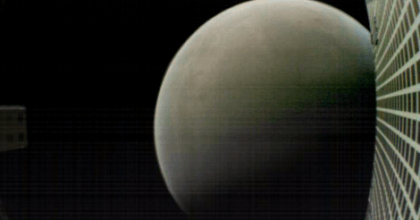
Some weeks it can be tricky to find a way into the science news that might be of interest to those outside the specific community of investigation. But not this week. Climate change, major space missions, and human bioengineering command our attention, and all three were in the headlines in the past four days. So let’s take a quick survey of all three.
Most straightforward is the landing of NASA’s InSight robot on Mars. We–or rather our robots–have been there before, which can make it easy to take for granted just how remarkable it is to predict where another planet will be years in advance with precision sufficient to hit it from 34 million miles away. We’ve only had the capability to act on those predictions for a few decades; next year will be the 50th anniversary of the first moon landing. And the notable feat of getting InSight there is just the beginning. The real fruits of this project will be realized in years to come, hopefully including a better understanding of whether Mars currently hosts or has ever supported life (most likely microbial, a frontier we are still exploring here at home).
Data from the InSight mission will also stoke further interest in colonizing Mars, which for some offers hope for the continuation of humanity if this planet should become inhospitable and for others is a fantasy that will take resources away from caring for our current home. That brings us to the second headline, the release of volume II of the Fourth National Climate Assessment by the United States federal government. The most basic summary of the report, that climate change due to human activity will have an increasing detrimental impact on human flourishing, is perhaps not so newsworthy since it is consistent with the findings of previous assessments in the series and with other climate science reports. At the same time, further action is needed to slow the rate of change and mitigate the consequences, making such assessments unfortunately still essential. Of particular note is the fact that the impact and consequences of climate change will not be distributed uniformly or felt equally. Some of us may be able to live as if nothing is happening, and some may even benefit, at least in the short term. This makes it all the more important to pay attention to comprehensive analysis and give that more weight than our own personal experience, however much our natural cognitive tendencies would lean the other way.
And while we’re talking about cognitive tendencies, you might be interested in this discussion of cybernetics and souls and the essential embodiment of our minds. One of the topics is the physical reality of emotions and the implied challenge of reproducing emotion in computers. That reminded me of my idea that my car is happy to see me when I approach, because it has a physical reaction; its interior lights come on and it unlocks the driver’s side door. Granted, it has no ability to sense or be aware of that physical reaction, but arguable it possesses a precursor to emotion that even sophisticated artificial intelligences like IBM’s Watson or AlphaGo lack.
Questions about souls may also arise when thinking about human cloning and other forms of human bioengineering. And so finally we have the announcement that He Jiankui and his research group had applied CRISPR genome editing technology to artificially inseminated human embryos, two of whom have so far been brought to term and delivered. The work was carried out in China; the US and many other countries prohibit editing human genomes in this way because we do not know the consequences of passing on edited genes to children or even how it would effect the originally modified person over their entire lives. It should be emphasized that the claimed results have not been vetted by the wider scientific community; no technical papers or reports have been reviewed and published, only news stories. Still, it adds urgency to the ethical considerations around when and how to apply this technology in humans, if at all. This particular application was intended to provide protection against HIV infection, although other proposed uses range from removing genetic risk factors for diseases to providing enhancements or desirable physical attributes. The linked article does a good job pointing out that even something as straightforward as modifying a single gene to confer the same HIV resistance that occurs naturally in some populations, there are still tradeoffs in terms of increased susceptibility to other infections. This complexity is an important consideration when it comes to the ethical questions.
All of these stories represent new frontiers for human experience, for better and worse. So over the next few weeks, we are going to unpack the idea of newness as we prepare to celebrate the firstfruits of God’s new creation as represented by his incarnation as Jesus.
Andy has worn many hats in his life. He knows this is a dreadfully clichéd notion, but since it is also literally true he uses it anyway. Among his current metaphorical hats: husband of one wife, father of two teenagers, reader of science fiction and science fact, enthusiast of contemporary symphonic music, and chief science officer. Previous metaphorical hats include: comp bio postdoc, molecular biology grad student, InterVarsity chapter president (that one came with a literal hat), music store clerk, house painter, and mosquito trapper. Among his more unique literal hats: British bobby, captain’s hats (of varying levels of authenticity) of several specific vessels, a deerstalker from 221B Baker St, and a railroad engineer’s cap. His monthly Science in Review is drawn from his weekly Science Corner posts — Wednesdays, 8am (Eastern) on the Emerging Scholars Network Blog. His book Faith across the Multiverse is available from Hendrickson.

Leave a Reply